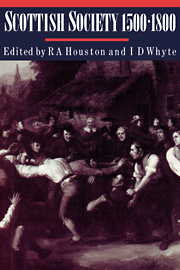Book contents
- Frontmatter
- Contents
- List of tables
- Notes on contributors
- List of abbreviations
- Introduction: Scottish society in perspective
- 1 Population mobility in early modern Scotland
- 2 Scottish food and Scottish history, 1500–1800
- 3 Continuity and change in urban society, 1500–1700
- 4 Women in the economy and society of Scotland, 1500–1800
- 5 Social responses to agrarian ‘improvement’: the Highland and Lowland clearances in Scotland
- 6 ‘Pretense of blude’ and ‘place of thair dwelling’: the nature of highland clans, 1500–1745
- 7 North and south: the development of the gulf in Poor Law practice
- 8 Scotland and Ireland, 1600–1800: their role in the evolution of British society
- 9 Kindred adjoining kingdoms: an English perspective on the social and economic history of early modern Scotland
- Bibliography of printed sources and secondary works
- Index
5 - Social responses to agrarian ‘improvement’: the Highland and Lowland clearances in Scotland
Published online by Cambridge University Press: 08 March 2010
- Frontmatter
- Contents
- List of tables
- Notes on contributors
- List of abbreviations
- Introduction: Scottish society in perspective
- 1 Population mobility in early modern Scotland
- 2 Scottish food and Scottish history, 1500–1800
- 3 Continuity and change in urban society, 1500–1700
- 4 Women in the economy and society of Scotland, 1500–1800
- 5 Social responses to agrarian ‘improvement’: the Highland and Lowland clearances in Scotland
- 6 ‘Pretense of blude’ and ‘place of thair dwelling’: the nature of highland clans, 1500–1745
- 7 North and south: the development of the gulf in Poor Law practice
- 8 Scotland and Ireland, 1600–1800: their role in the evolution of British society
- 9 Kindred adjoining kingdoms: an English perspective on the social and economic history of early modern Scotland
- Bibliography of printed sources and secondary works
- Index
Summary
Enclosure and consolidation altered the organisation, function and purposes of land from one in which several members of a community had rights of use to a new condition in which single occupants had complete control. Jerome Blum, in his analysis of the decline of the old rural order in Europe, has characterised it as ‘the single most important departure from the traditional agriculture, heralding as it did the switch from communalism with its collective controls to individualism with its private rights of property and its individual freedom of action’. Consolidated holdings were not new in Europe before the seventeenth century. Proprietors sometimes enclosed lands for their own use, while in mountainous and forested regions peasants had long lived in consolidated holdings and they were common also in the maritime provinces of the continent. Enclosures in England were far advanced in the south east and in pockets of the south west and north in the early modern period, mainly, though not exclusively, due to the impact of an expanding market for wool. However, in the eighteenth century the forces making for consolidation accelerated rapidly. Two influences in combination operated throughout western Europe. First, an ideological attack on communalism was mounted by agronomists and political economists. Second, a massive increase in the markets for foods and raw materials as a result of the rise in population and the expansion in towns, cities and industry created both pressures and incentives for improvements in agricultural productivity.
It is clear that these stimuli, to a greater or lesser extent, were touching virtually all countries in western Europe.
- Type
- Chapter
- Information
- Scottish Society, 1500–1800 , pp. 148 - 168Publisher: Cambridge University PressPrint publication year: 1989
- 5
- Cited by



